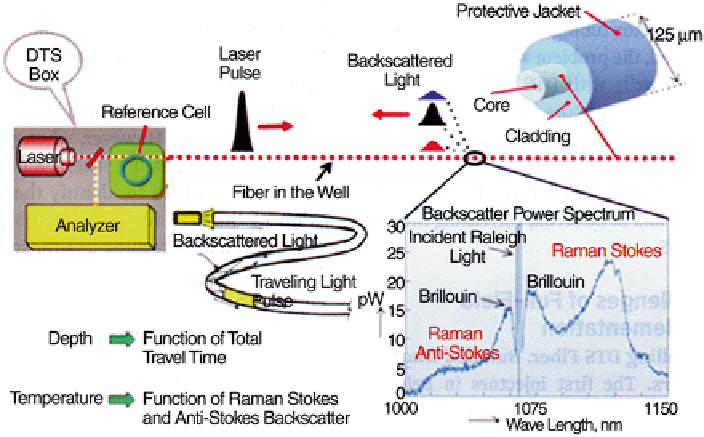Environmental Engineering Reference
In-Depth Information
Practical Applications of Light Scattering in DTS
In order to place the above theoretical descriptions of scattering mechanisms in
perspective we need to understand how these different possibilities of light scatter-
ing can be used to tell us something of practical use. In
Rayleigh Scattering
there is
no exchange of energy and so incident and scattered photons have the same energy.
However there can also be scattering where there is an exchange of energy and
this is referred to as
Stokes Scattering
where an atom or molecule absorbs energy.
In this case the scattered photon has less energy than the incident photon. In other
cases an atom or molecule can contribute energy and the scattered photon has more
energy than the incident photon. This is referred to as
Anti
-
Stokes Scattering
.
The Raman interaction thus leads to two possible outcomes: the material absorbs
energy and the emitted photon has a lower energy than the absorbed photon. This
outcome is labeled
Stokes Raman Scattering
. Alternately the material loses energy
and the emitted photon has a higher energy than the absorbed photon. This outcome
is labeled
Anti
-
Stokes Raman Scattering
.
Figure
14.2
illustrates the principle of DTS. A laser light source (see the “DTS
Box”) sends a very short pulse of light down the fiber optic cable installed in the
well. A small fraction of the photons are backscattered from every point along the
well and detected back at the analyzer.
There the detected change in frequency is interpreted as a temperature and the time
taken for the light to travel from the laser back to the detector as a measure of distance
from the light source and hence depth in the well. Since there are two effects that need
to be detected the analyzer employs an interferometer for the frequency shifts in
Brillouin scattering a dispersive grating spectrometer for the Raman scattering.
Fig. 14.2
Principle of distributed temperature sensing (DTS) with optical fiber. Courtesy SPE
144116

Search WWH ::

Custom Search